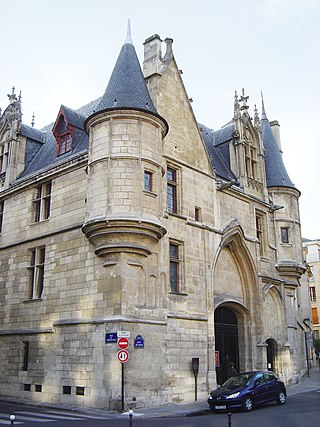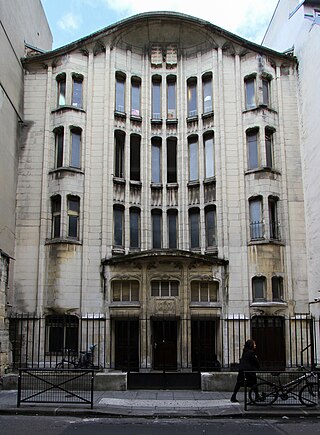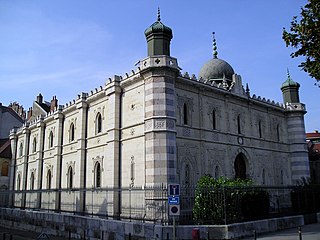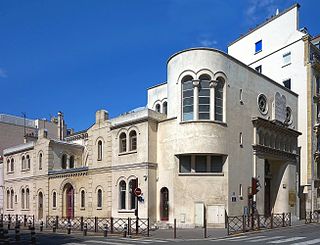
The Marais is a historic district in Paris, France. It spreads across parts of the 3rd and 4th arrondissements on the Rive Droite, or Right Bank, of the Seine. Having once been an aristocratic district, it is home to many buildings of historic and architectural importance. It lost its status as a fashionable district in the late 18th century, with only minor nobles calling the area home. After the French Revolution, the district fell into disrepair and was abandoned by nobility. After a long period of decay, the district has undergone transformation in recent years and is now once again amongst the more fashionable areas of Paris, known for its art galleries, upscale restaurants and museums.

The Agoudas Hakehilos Synagogue is an Orthodox Jewish congregation and synagogue, located at 10 rue Pavée, in Le Marais quarter, in the IVe arrondissement of Paris, France. The synagogue is commonly referred to as the Pavée synagogue, rue Pavée synagogue, or Guimard synagogue, and was completed in 1914, designed by Hector Guimard in the Art Nouveau style. The congregation worships in the Ashzenazi rite, led by Rav Moredekhai Rottenberg, the son of the late Rav Haim Yaakov Rottenberg, known as the Rouv. The synagogue is open to the public.

The Sedan Synagogue is a former Jewish congregation and synagogue, located at 6, avenue de Verdun, Sedan, in the Ardennes department of the Grand Est region, in northern France. The synagogue was built by the Jewish community in 1878. Although the Jews were deported during World War II, the synagogue survived. The congregation used to worship in the Ashkenazi rite.
David Feuerwerker was a French Jewish rabbi and professor of Jewish history who was effective in the resistance to German occupation the Second World War. He was completely unsuspected until six months before the war ended, when he fled to Switzerland and his wife and baby went underground in France. The French government cited him for his bravery with several awards. After the war, he and his wife re-established the Jewish community of Lyon. He settled in Paris, teaching at the Sorbonne. In 1966, he and his family, grown to six children, moved to Montreal, where he developed a department of Jewish studies at the University of Montreal.

The Union Libérale Israélite de France, commonly referred to as the rue Copernic synagogue, is a Reform Jewish congregation and synagogue, located in the XVIe arrondissement of Paris, France. Inaugurated on 1 December 1907, it is the oldest Reform synagogue in France.

The Synagogue of Besançon is a Jewish congregation and synagogue, located at 23 Quai de Strasbourg, in the Battant area, near the old part of town, in the city of Besançon, in the Bourgogne-Franche-Comté region of France. The stone synagogue was built in 1869 and was inaugurated on 18 November.

The Great Synagogue in Lyon is an Orthodox Jewish congregation and synagogue located at 13 quai Tilsitt in the IIe arrondissement of Lyon, France. Designed by Abraham Hirsch in the Byzantine Revival style, the synagogue was built between 1863 and 1864 and renovated in 2014. The building was listed as a monument historique on 5 December 1984. The congregation worships in the Ashkenazi rite.

The Synagogue de Nazareth, officially Synagogue de la rue Nazareth, is an Orthodox Jewish congregation and synagogue, located on the Rue Notre-Dame-de-Nazareth, in the IIIe arrondissement of Paris, France. The synagogue is the oldest of the 'great' synagogues of Paris.

The Grand Synagogue of Paris, generally known as Synagogue de la Victoire or Grande Synagogue de la Victoire, is an Orthodox Jewish congregation and synagogue, located at 44, Rue de la Victoire, in the IXe arrondissement of Paris, France.

The Versailles Synagogue is a Jewish congregation and synagogue, located at 10, rue Albert Joly in Versailles in the Yvelines department, in the Île-de-France region of France. Built between 1884 and 1886 by the architect Alfred-Philibert Aldrophe, it was inaugurated in 1886, and is one of the oldest synagogues in the Île-de-France region. Mrs Furtado Heine provided significant financial support to the establishment of the synagogue.

The Synagogue of Neuilly is an Orthodox Jewish congregation and synagogue, located at 12 rue Ancelle, in Neuilly-sur-Seine, in the Hauts-de-Seine department, west of Paris, France. The synagogue was built in 1878. The congregation used to worship in the Ashkenazi rite; however is now Sephardi.

The Synagogue of Vesoul is a former Jewish congregation and synagogue, located at 11 rue du Moulin-des-Prés, in the city of Vesoul, in Haute-Saône department of the Bourgogne-Franche-Comté region of France. Whilst active, the congregation worshipped in the Ashkenazi rite.

The Belfort Synagogue is a Jewish congregation and synagogue, located at 6, rue de l'As-de-Carreau, in the city center of Belfort, in the Bourgogne-Franche-Comté region of France. The congregation worships in the Ashkenazi rite.

The Synagogue Don Isaac Abravanel, also known as the Synagogue de la Roquette, is an Orthodox Jewish congregation and synagogue, located in the XIe arrondissement of Paris, France. Designed by architects Alexandre Persitz and Arthur-Georges Héaume in the Modernist style, the synagogue was built in 1962 for Jews who emigrated to France from Algeria, Morocco and Tunisia as a result of decolonization. The congregation worships in the Sephardi rite.

The synagogue of Guebwiller is a Jewish congregation and synagogue, located at 7, rue de l'Ancien-Hôpital, in Guebwiller, Haut-Rhin, France.

On the night of October 2–3, 1941, six synagogues were attacked in Paris and damaged by explosive devices places by their doors between 2:05 and 4:05 am. The perpetrators were identified but not arrested.

Lille Synagogue is a Jewish congregation and synagogue, located at 5, rue Auguste Angellie, in Lille, in the Hauts-de-France region of France. The congregation worships in the Ashkenazi rite.

The Great Synagogue of Marseille is a Jewish congregation and synagogue, located on Rue Breteuil in the 6th arrondissement of Marseille, France. The building was listed as a monument historique in 2007. The congregation worships in the Sephardi rite.

The Great Synagogue of Bordeaux is a Sephardic Jewish congregation and synagogue, located at 6 Rue du Grand Rabin Joseph Cohen, in Bordeaux, Gironde, in the Nouvelle-Aquitaine région of France.



















